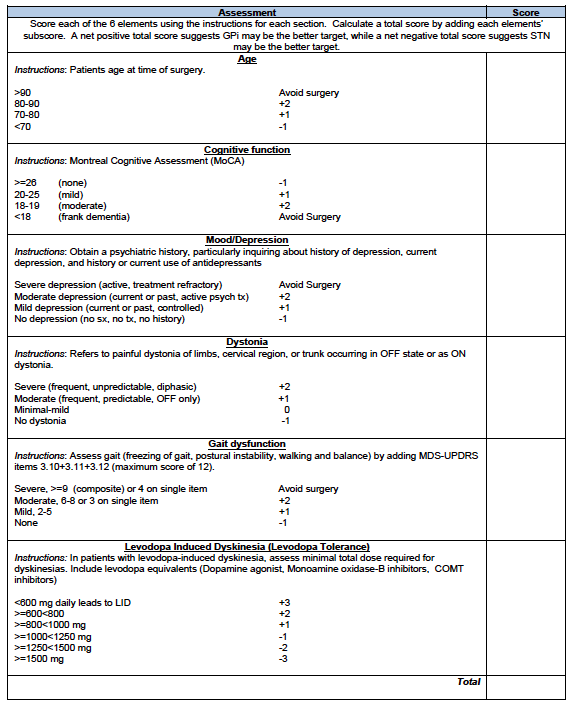Category: Surgical Therapy: Parkinson's Disease
Objective: After the creation of a tool to aid in target selection for deep brain stimulation (DBS) in Parkinson’s disease (PD), our goal is to show how we were able to integrate it into our center and show its correlation with consensus opinion.
Background: Two targets exist for DBS in PD, the subthalamic nucleus (STN) and globus pallidus interna (GPi). Although there are advantages and disadvantages to implanting in either target, current evidence does not guide selection of the appropriate target in the individual patient. We believe that in select cases, certain factors can help to determine the ideal target for patients.
Method: Previously we reported a tool [Table 1] for indicating STN or GPI implantation following a Pubmed search of DBS studies comparing sites. We investigated patients retrospectively who had already received DBS, and blindly applied the tool to observe the correlation between the tool selected site and the consensus opinion selected site. Patients who were scheduled for future DBS placements were also prospectively investigated, with the tool applied by a blinded participant and consensus opinion decided independently. We then compared the congruency of results from the tool and consensus opinion. At present, 51 patients have had the tool applied to their case, with 34 undergoing DBS placement.
Results: We used the previously developed tool on prospective DBS patients in our clinic in both a retrospective and prospective fashion. Of 34 patients the tool was applied to, we observed 73% congruency between the tool and consensus opinion, excluding cases where the tool selected either site. The tool selected either site in 12% of cases. Consistently, the target selected by the tool matched up with the group’s consensus on where to implant.
Conclusion: We have created and implemented a tool used in our center that we hope will aid in the decision on where to implant. We have previously shown its ease of use, and now have demonstrated that more often than not it correlates with consensus opinion. A blinded participant can easily utilize it if a consensus opinion cannot be reached. We will continue to compare the tool to consensus opinion in hopes of ultimately using it as an objective guide when consensus cannot be reached.
To cite this abstract in AMA style:
R. Burke, L. Meytin, D. Kremens, J. Ratliff, A. Sharan, C. Wu, T. Liang. An Objective Tool to Guide Target Selection for DBS in PD (GPi vs STN)- integration into Thomas Jefferson’s multidisciplinary Movement Disorders Center, an Update [abstract]. Mov Disord. 2020; 35 (suppl 1). https://www.mdsabstracts.org/abstract/an-objective-tool-to-guide-target-selection-for-dbs-in-pd-gpi-vs-stn-integration-into-thomas-jeffersons-multidisciplinary-movement-disorders-center-an-update/. Accessed July 3, 2025.« Back to MDS Virtual Congress 2020
MDS Abstracts - https://www.mdsabstracts.org/abstract/an-objective-tool-to-guide-target-selection-for-dbs-in-pd-gpi-vs-stn-integration-into-thomas-jeffersons-multidisciplinary-movement-disorders-center-an-update/

